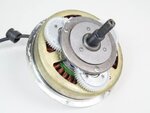Ann,
I looked at that simulator. I have a Prodeco X3, and can't find anything to indicate the brand of motor. The drop down menus make it hard to say what might be close to the motor I have. The curves are interesting because they show where the motors tend to be efficient.
I'd settle for real world amp hours over some kind of course. That is very easy to measure, like with one of these $20 Chinese Watts Up knock-off. I think ebikes are meant to be pedal power plus motor, so the total watts are a mix. This is where I get baffled. If I am moving along at 18 mph, pedaling steadily, but moderately, what is the wattage from the motor, and how do the amp hours add up? Is the motor reasonably efficient when I pedal? More efficient? We don't really need to know this much. I would like to know, for instance, if I went to a mid-drive, doing what I do, similar bike, would the battery last a lot longer, or would I just need a smaller battery, etc. My solution for everything is to buy 1) a bigger battery 2) a second battery.
They all exaggerate range, let's say. But is anyone making claims that their drive train is more efficient? Does anyone say "You'll go 50% farther with our mid-drive"?
The best I can say is that on a typical 20 mile ride, I end up with a recharge time of around 3.5 + hours, and the full recharge time is around 7 hours. I have kill-a-watt meter that shows what is coming out of the circuit, the AC watts, so you can make educated guesses about what is going into the battery. Using the AC out, through the meter, works out to be 90 watts, converted to 44 v, and that is about 2 amps per hour, so it's maybe 8 amp/hours into the battery after a 20 mile ride. The battery is 16 AH.
Still, I would take real life experiences where people explained how they ride. I'll take what Pete does, but he seems to get his bikes for a week or two.
For me, I don't think too much about the limits, because the battery seems to be good for 40 miles, and that is farther than I want to go, at this point. I think we need fairly general information, but fairly precise. Like with cameras, just set the parameters and do the same for every bike. Maybe?
The calculator I referenced shows what happens as you push speed, climb hills, and ride into winds. You basically kill your battery. Those are things people have to consider.

